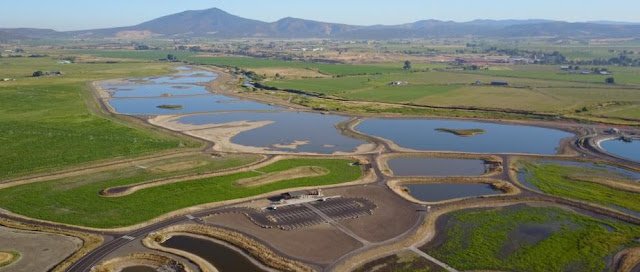I woke at daybreak, but rolled over and dozed
until I heard Jody and Harold stirring, then showered and came downstairs for a
cup of coffee, a bowl of cereal, and congenial conversation. Packing, I said my goodbyes and headed north,
leaving the half-bottle of Basil Hayden's Kentucky straight bourbon whiskey on
the counter, as I believe that Harold will enjoy it.
I
gassed up in Bend and headed north to the Crooked River wetlands, just
northwest of Prineville. These are
settling ponds for the wastewater treatment plant for the town, finished in
2017.
This 120-acre, multipurpose
project expanded the City of Prineville’s wastewater capacity, lowered
residential and business development charges, stabilized monthly wastewater
rates, and created a new public hiking trail system with numerous educational
opportunities, improving riparian and instream conditions in the Crooked River.
The
reason I came here was to ‘twitch’ the Tundra Bean-goose that was found by Tom Crabtree on April 19th.
 |
| There it is - back by the fence . . . |
This is not a
“Life Bird” for me, as I’d seen the one that showed up on the Oregon Coast at
Nestucca NWR back in the winter of 2014-15.
But, this Asian visitor is rare enough that I couldn’t pass up the
opportunity to see one again.
The
species is only rarely seen in the lower 48 states, as it nests in Siberia and
usually winters in northern Asia and Europe.
There
was a trio of birders ahead of me looking for the bird, but had gone past where
I scoped it from the dike. I hollered
and got them on the bird, and they were quite happy.
I
continued walking around the ponds for about 2 ½ hours, and was impressed with
the numbers of Tree Swallows taking advantage of the nest boxes erected around
the facility.
 |
| In a field with Canada Geese |
 |
| Tree Swallow male |
 |
| There were plenty of Chironomids to feed the swallows |
Then, I
saw a white bird flying, and finally it landed, giving me a view of an leucistic
Brewer’s Blackbird.
The
bird is not an albino.
Genetically,
these are two very important concepts of inheritance, and there is confusion
with the terms leucism and albinism.
Leucism
(from the Greek, λευκός or leukos white) is a genetic peculiarity due to a
gene, recessive in most cases, which gives a white color to the feathers which
normally would have a different color.
Albinism
(from the Latin albus, white) is a congenital anomaly consisting of a total or
partial deficiency of melanin pigmentation in the skin, iris and choroid, and
also in the plumage. It is caused by an absence or defect of the enzyme
tyrosinase, which is involved in the synthesis of melanin.
Finally,
I got in the car and headed for home, driving over the shoulder of Mount Hood
on Highway 26 and back to Olympia on I-5.
I’d been gone for three weeks, and it was good to sleep in my own bed .
. .
Crooked
River Wetlands eBird Checklist is Here











No comments:
Post a Comment